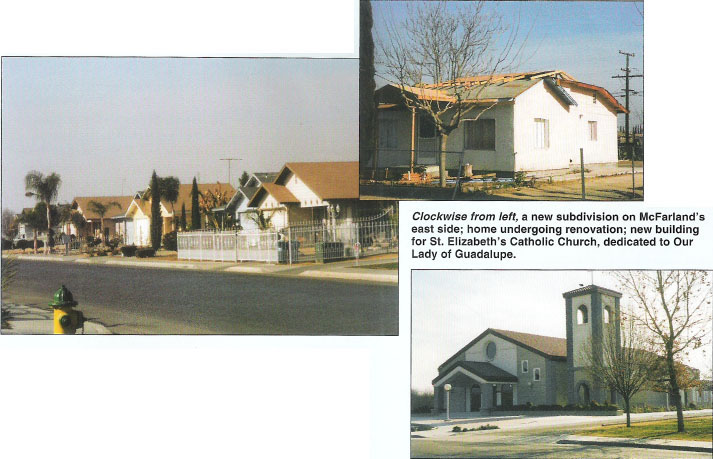All Issues
The new rural California: Farmworkers putting down roots in Central Valley communities
Publication Information
California Agriculture 54(1):33-34. https://doi.org/10.3733/ca.v054n01p33
Published January 01, 2000
PDF | Citation | Permissions
Full text
Clockwise from left, a new subdivision on McFarland's east side; home undergoing renovation; new building for St. Elizabeth's Catholic Churuch, dedicated to Our Lady of Guadalupe.
At times, rural agricultural communities have been viewed as chronically impoverished, overgrown labor camps with few prospects for improvement. The common wisdom is that costly public assistance will be needed to ensure the social integration of poor, undocumented, unskilled, uneducated, non-English-speaking, foreign-born farmworkers and their families.
Over the past 15 years, anthropologists with UC Santa Barbara have documented the settlement of former migrant farmworkers, mostly from rural Mexico, into California towns and communities located near important agricultural production sites (Palerm 1989, 1991). This ethnographic field research continues to examine the people who inhabit impoverished but rapidly changing agricultural communities (Garcia 1992; Krissman 1996; Haley 1997; Figueroa; Palerm 1999a, 1999b).
Despite undeniable conditions of persistent and concentrated poverty, the research paints a more complex picture. A dozen research sites, under study by anthropologists since the mid-1980s, reveal another less familiar facet. Many settlers have become homeowners and are transforming derelict structures into attractive dwellings. Of 72 immigrant families I began studying in 1989,64 still live in the same community and 32 now own their homes (compared with 10 in 1989) (Palerm 1991). There is nothing transient about this behavior. Rather, it clearly demonstrates a stubborn determination on the part of young immigrant families to homestead and build new lives in rural California.
Likewise, unprecedented numbers of foreign-born rural Californians have sought and been granted U.S. citizenship in recent years. As a result, they are becoming more engaged in the local political life. A review of city Web sites shows that there is hardly a city council in California's agricultural heartland that does not include several Latino officials. New civic and non-governmental, community-based organizations have mobilized to improve parks, churches, schools and other community institutions.
Revived towns often include new small businesses such as groceries, laundries, video rentals, repair shops, panaderias (bakeries), carnicerias (butchers), liquor stores, travel agencies, restaurants and discount stores. A 1987 business survey in Guadalupe, a farming town in Santa Barbara County, found that 30 of the town's 67 businesses were registered to Hispanic owners or operators. By 1999, Guadalupe had 194 businesses, 82 registered to Hispanics and the rest to Anglo, Portuguese, Italian, Japanese, Korean, Filipino or unknown owners. With these businesses, a new merchant class is emerging that demonstrates budding socioeconomic and occupational differentiation.
Likewise, many immigrant farmworkers and their children are becoming skilled and valued laborers as, for example, machinists, irrigators, chemical applicators, mechanics and labor foremen. Some are employed by farm enterprises as crop managers, accountants, and sales and marketing representatives, while others have percolated up into state employment as farm advisors and crop inspectors. Immigrants have also become successful entrepreneurs as, for example, farm labor contractors and, against all odds, as independent farmers. Of the 72 families I began studying in 1989, most continue to carve out their existence from farm work, but seven are locally self-employed as a barber, beautician, two independent growers, two roofers and an auto mechanic.
Some immigrants to Central Valley towns have become successful business-persons, such as barbers, agricultural consultants or restaurateurs.
The town of McFarland, located in Kern County at the southern end of the San Joaquin Valley, is a good example of the changes under way in rural California towns. When UC anthropologists first visited McFarland in 1986, they encountered a dusty, blighted community surrounded by profitable grape, almond, orange, kiwi, rose and cotton farms. Nearby industrial wineries, almond hulling plants, cotton gins, and state-of-the-art fruit and vegetable packing sheds further demonstrated the importance of agricultural investment and farm production.
On the east side of Highway 99, which divides McFarland into two parts, stood a collapsing Mexican “shantytown.” The “better” west side showed clear signs of decay as former inhabitants took flight and new immigrants, mostly from the Mexican state of Zacatecas, crowded into the vacated homes. Only one business remained open in the once-busy downtown.
From 1970 to 1986, McFarland's population increased about 50% to 6,350, satisfying the growing farm labor demand but putting tremendous pressure on local housing, community services and schools. In short, McFarland looked a lot like an overgrown and overcrowded labor camp populated by transient and impoverished farmworkers.
McFarland's population has grown to more than 8,000 (in 1999), still mostly poor immigrant farmworkers from the Zacatecan towns of Huanusco and Jalpa. But many of the small, modest homes in the east side have been repaired and painted, giving the neighborhood an almost suburban look. A brand-new, oversized church devoted to Our Lady of Guadalupe stands prominently by the old Mexican colonia. Across the highway, the west side is undergoing a renewal, with a downtown redevelopment plan being implemented and many new businesses such as a Kaweah National Bank, McDonald's and Chevron food mart.
In the north end of town a lienzo charro (Mexican rodeo) has been erected which draws paisanos (countrymen) from throughout the southern San Joaquin Valley to spectacular shows and competitions. McFarland's high school has generated 50 teachers during the past decade; its crosscountry track team has won the state championship seven times, a source of tremendous community pride. A new maximum-security prison in the south end of town offers a handful of new jobs to locals. All but one of the city council members, including the mayor, are Latino, as well as most of the city's planning committee. McFarland no longer resembles an overgrown farm labor camp, but rather a real and vibrant community peopled by immigrant farmworkers with many aspirations and the will to realize them.
The future prospects for California's rural immigrant communities are still uncertain and difficult to predict. Although we understand quite well the external social, political and economic forces that spawned them, we are nevertheless far from understanding their internal dynamics as real human communities and legitimate places in the state's realpolitik. One can safely assume that the population that inhabits these communities will continue to root itself into the agricultural landscape, as long as California farms continue to demand their labor.






